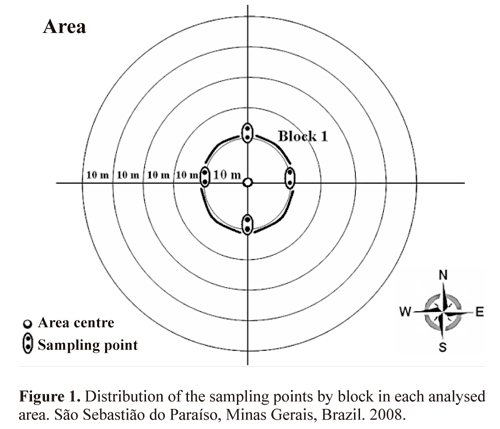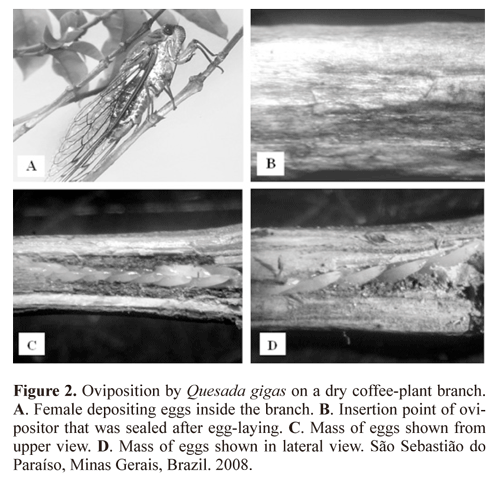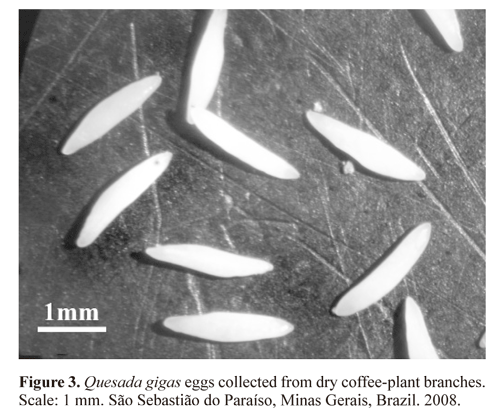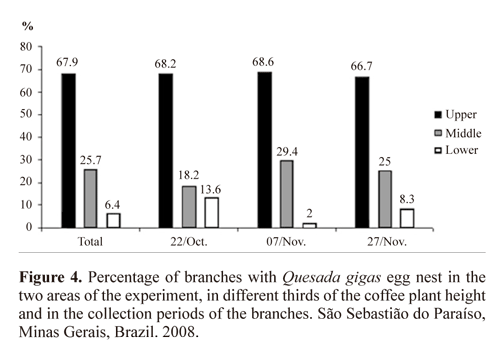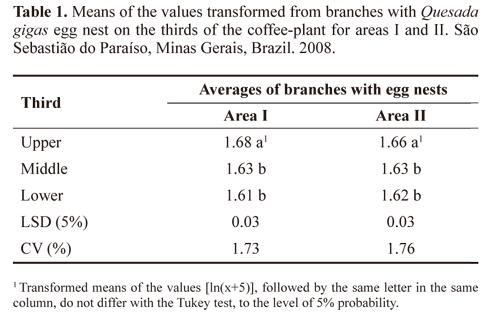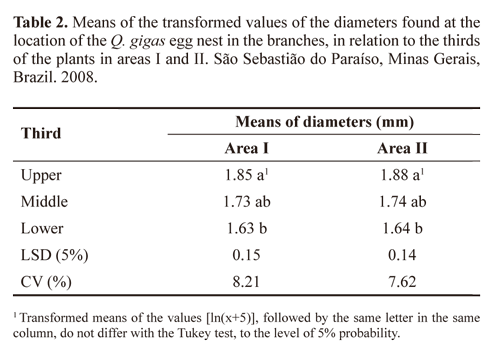Services on Demand
Journal
Article
Indicators
-
 Cited by SciELO
Cited by SciELO -
 Access statistics
Access statistics
Related links
-
 Cited by Google
Cited by Google -
 Similars in
SciELO
Similars in
SciELO -
 Similars in Google
Similars in Google
Share
Revista Colombiana de Entomología
Print version ISSN 0120-0488
Rev. Colomb. Entomol. vol.38 no.1 Bogotá Jan./June 2012
Sección Agrícola
Oviposition of Quesada gigas (Hemiptera: Cicadidae) in coffee plants
Oviposición de Quesada gigas (Hemiptera: Cicadidae) en plantas de café
SERGIO T. DECARO JÚNIOR1, NILZA M. MARTINELLI1,2, DOUGLAS H. B. MACCAGNAN3 and EDUARDO S. D. B. P. RIBEIRO1
1 Agricultural Engineer. Depto. Fitossanidade, FCAV/UNESP, access path Prof. Paulo Donato Castellane s/n, 14884-900, Jaboticabal, SP, Brazil., du_delbel@yahoo.com.br, sergiotdecaro@yahoo.com.br. Corresponding author.
2 Dr. Agricultural Engineer. nilza@fcav.unesp.br.
3 Dr. Unidade Universitaria da UEG de Ipora. Av. R-2, Q. 1, 76200-000, Ipora, GO, Brazil. douglashbm@hotmail.com.
Received: 7-sep-2011 - Accepted: 3-mar-2012
Abstract: Branches of coffee-plant were collected in Sao Sebastiao do Paraíso County, Minas Gerais State, at the Experimental Station of the Agricultural Research Company (Empresa de Pesquisa Agropecuaria de Minas Gerais - EP-AMIG), with the aim of studying various aspects of oviposition by Quesada gigas (Hemiptera: Cicadidae). The number of branches with Q. gigas egg nests was analyzed, as well as the number of nests per branch, the eggs per nest and the diameter of the egg nest location on the branch. The preference for oviposition either on alive or dry branches and the size of the egg were assessed. Egg-laying occurred only on dry branches. The mean of the branch diameter on which the egg nests occurred was 2.5 ± 0.53 mm. The number of eggs per nest averaged 13.2 ± 4.9, and the number of egg nests per branch was 2.2 ± 1.74. The eggs were 1.9 ± 0.08 mm long by 0.5 ± 0.04 mm wide. The largest diameters of the branches containing egg nests were found on the upper third of the trees, as well as the greatest amount of branches with egg nests, of egg nests per branch and of eggs per nest. The correlation relationship between all of the experiment variables was positive.
Key words: Cicadoidea. Cicada. Coffea arabica. Dry branches. Egg nest.
Resumen: Se realizaron colectas de ramas de plantas de café en el municipio de Sao Sebastiao do Paraíso, estado de Minas Gerais, en la Estación Experimental de la Empresa de Investigación Agropecuaria (Empresa de Pesquisa Agropecuaria de Minas Gerais - EPAMIG), con el objetivo de estudiar la oviposición de Quesada gigas (Hemiptera: Cicadidae). Se analizaron el número de ramas con postura de Q. gigas, postura por rama, huevos por postura y diámetro del sitio de postura de la rama. Se evaluó la preferencia por oviposición en las ramas verdes o secas y las dimensiones de los huevos. Las posturas solo ocurrieron en las ramas secas. El promedio del diámetro de la rama en que las posturas ocurrieron fue 2,5 ± 0,53 mm. El número de huevos por postura fue em promedio 13,2 ± 4,9, y el número de posturas por rama fue de 2,2 ± 1,74. El huevo tiene dimensiones de 1,9 ± 0,08 mm de longitud por 0,5 ± 0,04 mm de ancho. Los mayores diámetros de ramas que contienen posturas, mayor número de ramas con postura, mayor número de posturas por rama y mayor número de huevos por postura se encontraron en el tercio superior. La correlación entre las variables del experimento fueron positivas.
Palabras clave: Cicadoidea. Cicada. Coffea arabica. Ramas secas. Postura.
Introduction
In Brazil, the occurrence of cicadas (Hemiptera: Cicadidae) on coffee plants Coffea arabica L. (Rubiaceae) causes damage when the nymphs occupy the plant roots. The species most often responsible for coffee plant damage are Quesada gigas (Olivier, 1790), Fidicinoides pronoe (Walker, 1850), Carineta fasciculata (German, 1830), Carineta spoliata (Walker, 1858), Carineta matura (Distant, 1892), Dorisiana drewseni (Stal, 1854) and Dorisiana viridis (Olivier, 1790) (Martinelli and Zucchi 1997).
Souza et al. (1983) found that when holes were dug around infested coffee plants in the region of São Sebastião do Paraíso, state of Minas Gerais, Q. gigas and Fidicina sp. were found in 87% and 13% of the holes, respectively. In severely affected coffee plantations from the south of Minas Gerais state, an average of 242 moving nymphs were found per dug hole as many as 540 nymphs per hole were found on one occasion (Souza 2003)
The most damaging species for coffee tree plants is Q. gigas, which, in the nymph stage, requires a large amount of sap from the plant roots to complete its development (Souza et al. 2007). The infestation of this species in coffee crops is concentrated in some municipalities from Alto Paranaíba region, including the south of Minas Gerais state or more precisely São Sebastião do Paraíso and neighbouring municipalities. Thus, this region constitutes a center of infestation for all coffee tree plantations in this region (Martinelli 2004). The cicadas cause damage to mature crops and millions of coffee plants become infested to some extent (Souza et al. 2007).
Once oviposition is completed, some species use a type of wax to cover the opening created by the penetration of the ovipositor. This makes it difficult to locate the nests on the branches (Osborn and Metcalf 1920) and necessitates the manual opening of the branches in order to find the eggs. The discovery of the eggs is essential since they can indicate an infestation in a specific area.
Although recognized as a significant pest, studies concerning the biology Q. gigas on coffee plants have not been reported. Furthermore, little information about the behaviour and interaction of Q. gigas with its host are known. Such knowledge is crucial for the development of management techniques to control this pest. In the present study, the aim was to gather information related to oviposition by Q. gigas on coffee plants.
Materials and Methods
The experiment was set up in two areas of the Experimental Station of Minas Gerais Agricultural Research Corporation (EPAMIG) located in São Sebastião do Paraíso County 20°54’S 46°59’W 940 masl. This area has an average annual rainfall of 1,627 mm (Cwa). Two areas of approximately 1 hectare each were used. Area I contained plants of cultivar Catuai IAC 99 and area II contained plants of cultivar Acaiá Cerrado MG 1474. The plants were 10 and 13 years old, respectively, and grown in a dense system of cultivation.
Branches were collected on October 22nd and on November 4th and 27th in 2008. Based on reports by professionals of EPAMIG, who registered the flights of Q. gigas during this time, these collection dates corresponded with the period of the greatest incidence of cicada adults for the above mentioned location.
Starting from the center of each plot, the sampling points were distributed every 10 meters, in the north, south, east and western radii, up to 50 meters. At each sampling point, the respective plant was sampled along with one plant to the right on the same line. The collection points of each block refer to the four radii with the same distance in relation to the center, totalling five blocks for each area and four repetitions per block (Fig. 1).
Dry branches 40 cm long from the apex were collected. For branch collection, the coffee plant was divided into thirds. Two branches were removed from each upper, medium and lower third of the two sampled plants. In total, from the two areas, 40 points and 80 plants were sampled, totalling 1,440 dry branches for the experiment. To confirm only the dry branches as egg-nest oviposition substrates, 300 live branches of full physiological activity were also collected in the same areas and from different thirds of the coffee plant height.
The sampled plants had already been harvested of coffee grains, such that a considerable proportion of dry branches were available, to the detriment of the live and physiologically active branches. To eliminate potential interference, the plants were located far away from hedges and trees as well as from legal reservations or permanent preservation areas that host cicadas of the Q. gigas species.
The method of evaluation included the longitudinal opening of each branch with a blade, so that the wood fibers of the branch were carefully revealed in a manner that would not cause damage to the egg nest. The branches were analyzed very soon after collection to ensure that possible egg hatchings would not result in an underestimation in the counts of oviposition and eggs.
The number of branches with egg nests, the number of egg nests per branch, the number of eggs present in each egg nest and, using a paquimeter of 0.05 mm precision, the branch diameter at the location in which the egg nests were found were measured. For a sampling of 40 Q. gigas eggs that were collected, the length and width was measured, using a graded eye-piece attached to a stereoscopic microscope. The experiment was based on the first treatment (I), in accordance with the upper, middle and lower thirds, and secondary treatment (II), referring to the period of the branch collection.
The experiment design was based on entirely random blocks with two treatments and five repetitions per block, in the 3 x 3 factorial design. The values of the averages obtained in the experiment were transformed into the natural logarithm of x + 5 to diminish the coefficients of variation and stabilize the variances. The data was then subjected to the F test and the Tukey test, at a 5% probability level. To determine a relationship between the variables, a calculation of correlation was performed. The AGROESTAT v.1.0 program (Barbosa and Maldonado Jr., 2008) was used. The measurements presented in the text represent the mean ± standard deviation.
Results and Discussion
No egg nests were found in the 300 live branches analyzed, indicating a non-preference for Q. gigas oviposition in live branches. Of the 1440 dry branches analyzed, a minimum of one egg nest was found on 109 branches, representing 7.57% of the total dry branches analyzed. According to this result and in agreement with Souza et al. (2007), the Q. gigas egg nests occur exclusively on dry branches. With an absence of leaves, the dry branches facilitate the movement of the Q. gigas adults and provide necessary substrates for the oviposition to occur. According to Fonseca (1945), this preference for dry branches during oviposition may be explained by the absence of sap which, when present, is capable of making the eggs unable to hatch.
In total, 241 egg nests of Q. gigas were counted, with 2.2 ± 1.74 nests per branch. However, the greatest frequency of nest-containing branches contained only one egg nest (51%). The number of eggs per nest was 13.2 ± 4.9, providing a total of 3,181 eggs at the experiment.
The Q. gigas egg nest is endophytic and difficult to locate since the female cover the opening where the ovipositor was inserted. This seals the egg nest inside the branch and leaves no apparent mark. As there is not an entrance to permit access to the egg nest, this constitutes an adaptation to protect against possible predators, parasites, pathogens and rainwater. In general, the ovipositor insertion into the branch occurs a short distance below the apical node of each internode. The ovipositor is inserted into the branch core at nearly one centimeter towards the base of the internode, and thus indicates that the female positions her body parallel to the branch axis with her head pointing towards the branch’s apical region. The arrangement of the Q. gigas eggs in the egg nest occurs in a double line, with each egg being placed after the previous one and alternating the sides with an inclination angle relative to the branch axis (Fig. 2).
The eggs are milky white in color and spindle-shaped. The eggs measured eggs being 1.9 ± 0.08 mm long and 0.5 ± 0.04 mm wide (Fig. 3). These measurements are consistent with the size of the Q. gigas nymphs of the first instar shown in Maccagnan and Martinelli (2004). Depending on the developmental stage of the embryo, it is possible to see the eyes through the chorion as well as the completely-formed nymph during later developmental stages.
In both of the areas studied, the vertical distribution of the egg nests on the coffee plant indicated an insect preference for the upper third of the plant. The upper third had a larger average of egg nests, and this difference from the middle and lower thirds was statistically significant at a 5% probability level using the Tukey test (Fig. 4; Table 1). The upper third of the plant is where the largest number of plagiotropic branches producing coffee occur (Sandy et al. 2009). Many leaves are lost from these branches during harvest, causing the branches to dry out. This may explain the insect’s preference. Furthermore, the presence of dry branches can also be attributed to physiological and nutritional disturbances, the action of pathogenic agents and attack by pests.
In the coffee-growing regions of Minas Gerais, harvesting occurs predominantly between the months of June and August (Matiello et al. 2005). This period precedes the appearance of Q. gigas adults, which occurs in September (Martinelli and Zucchi 1987; Martinelli 2004). The concurrency between the availability of oviposition substrate, supplied by the quantity of dry branches, and the period in which the reproduction of Q. gigas occurs is an important factor that favors pest infestation.
In area II of the experiment, due to the periods in which collection took place, there was a difference in the average number of branches with egg nests. The averages from the second and third collections were greater, with 1.65 and 1.64 transformed values, respectively, compared to the first collection with 1.62, according to the Tukey test. The increase in the number of branches with egg nests in the collection made on November 7th relative to the collection on October 22nd is probably associated with the accumulation of oviposition by Q. gigas adults. This level was likely sustained for the collection made on November 27th because the majority of egg-laying activity had occurred prior to the date of the second collection. Thus, at that time, the cicada population was already diminished.
The diameter of the location on the dry branches on which the Q. gigas egg nests was present were found averaged 2.5 ± 0.53 mm. In this manner, the egg nests occurred mainly among the first 20 centimeters of the branch’s apical extremity.
In area I, differences in branch diameter size were noted upon comparing the thirds of the coffee plants (Table 2). In area II, there were differences between the averages of the diameter sizes compared with the thirds of the plants and compared with the averages corresponding to the collection period of the branches, as the branches were larger at the second collection. Q. gigas prefer the upper third of the plant for egg-laying and the female oviposits on larger diameters to avoid the overlapping of different egg nests. This fact is confirmed by the increase in branch diameter where the egglaying occurs over time.
Interactions were observed, by means of correlation calculation, revealing a positive correlation between all the experiment variables (Table 3). Thus, any increase of a certain variable will result in the increase of the others.
The presence of dry branches in coffee plantations where Q. gigas occurs may indicate susceptibility. These plants may serve as hosts for Q. gigas egg nests and, consequently, nymphs of its species. Therefore, as a first effort to reduce Q. gigas egg-laying, removal of dry branches from the crops is necessary. These branches must be collected on the upper third of the coffee plant, which is the preferred egg-laying location. The branches of the upper third are suitable for egg-laying spatial distribution studies aimed at Q. gigas management, studies of species biology under laboratory conditions, studies of infections by entomopathogenic fungus and many others studies involving species egg nests. The greater the dry branch diameter collected, the greater the likelihoods of finding egg nests. Furthermore, future research concerning the use of eggcide products for Q. gigas control must first consider the species’ endophytic oviposition on dry branches.
Acknowledgements
To Darlan Einstein do Livramento and Eguimar Pereira Xavier, from EPAMIG, and their whole Experimental Station for their support. To Tomomassa Matuo and Tomás Kanashiro Matuo, from IDEIA Enterprise, for their assistance offered during the work. To Walter Maldonado Junior, from FCAV/ UNESP, for his help on the experiment design. To Revista Colombiana de Entomología staff for the opportunity to send the present work. To the suggested evaluators for the analysis. To Universidade Estadual Paulista for its support.
Literature cited
BARBOSA, J. C.; MALDONADO JR, W. 2008. Agroestat, versão 1.0. Jaboticabal; FCAV, UNESP. [ Links ]
FONSECA, J. P. 1945. As cigarras do cafeeiro e seu combate. Boletim Agrícola (Brasil) 8: 297-304. [ Links ]
MACCAGNAN, D. H. B.; MARTINELLI, N. M. 2004. Descrição das ninfas de Quesada gigas (Olivier) (Hemiptera: Cicadidae) associadas ao cafeeiro. Neotropical Entomology 33: 439-446. [ Links ]
MARTINELLI, N. M.; ZUCCHI, R. A. 1987. Cigarras associadas ao cafeeiro. I. Gênero-Quesada Distant, 1905 (Homoptera, Cicadidae, Cicadinae). Anais da Sociedade Entomológica do Brasil 16: 51-60. [ Links ]
MARTINELLI, N. M.; ZUCCHI, R. A. 1997. Cigarras (Hemiptera: Cicadidae: Tibicinidae) associadas ao cafeeiro: distribuição, hospedeiro e chave para as espécies. Anais da Sociedade Entomológica do Brasil 26 (1): 133-43. [ Links ]
MARTINELLI, N. M. 2004. Cigarras associadas ao cafeeiro, pp. 527-537. En: Salvadori, J. R.; Ávila, C. T. B. da. (Eds.). Pragas de solo no Brasil. Embrapa Trigo. Passo Fundo. Brasil. 541 p. [ Links ]
MATELLO, J. B.; GARCIA, A. W. R.; ALMEIDA, S. R. 2005. Cultura do café no Brasil. Manual de recomendações. MAPA/Fund. Procafé. Varginha. Brasil. 434 p. [ Links ]
OSBRN, H.; METCALF, Z. P. 1920. Notes on the Life-History of the salt marsh cicada (Tibicen viridifascia Walker.). Entomological News (United States of America) 31 (9): 248-252. [ Links ]
SANY, E. C.; BOTELHO, C. E.; CARVALHO, A. M. de; GUIMARÃES, R. J.; CARVALHO, G. R.; MAGALHÃES, M. M. 2009. Produção de frutos de cafeeiros (Coffea arabica L.) em diferentes posições e orientações de ramos plagiotrópicos. Coffee Science (Brasil) 4 (1): 35-40. [ Links ]
SOUA, J. C. de. 2003. Cafeicultor: conheça as cigarras que atacam o cafeeiro e saiba como controlá-las com eficiência (revisada). Centro Tecnológico do Sul de Minas, Brasil. Circular Técnica 163: 4 p. [ Links ]
SOUA, J. C. de.; REIS, P. R.; MELLES, C. C. A. 1983. Cigarras do cafeeiro: histórico, reconhecimento, biologia, prejuízos e controle. EPAMIG. São Sebastião do Paraíso, Brasil. Boletim Técnico 5: 27 p. [ Links ]
SOUA, J. C. de; REIS, P. R.; SILVA, R. A. 2007. Cigarras-docafeeiro em Minas Gerais: histórico, reconhecimento, biologia, prejuízos e controle. 2. ed. EPAMIG. Belo Horizonte, Brasil. Boletim Técnico 80: 48 p. [ Links ]













